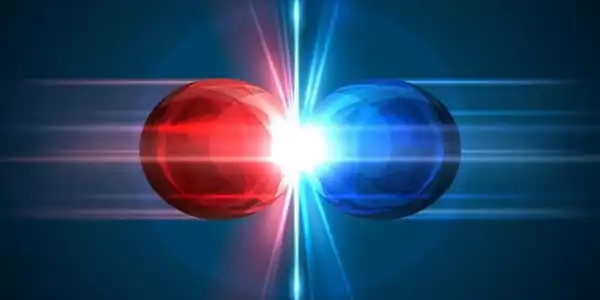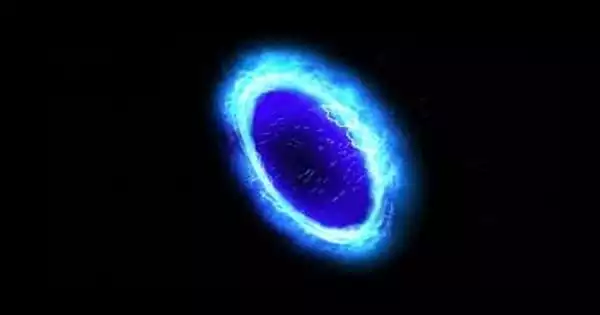Although the light has no mass, the European Union’s Large Hadron Collider (LHC) can convert light’s energy into massive particles. The departure angle of their debris is subtly distorted by quantum interference patterns in the light prior to the collision, according to physicists who studied matter-generating collisions of light. Their findings will aid physicists in correctly interpreting future experiments aimed at discovering “new physics” beyond the Standard Model.
Physicists studied matter-generating collisions of light and showed the departure angle of their debris is subtly distorted by quantum interference patterns in the light prior to the collision. It helps physicists accurately interpret future experiments aimed at finding ‘new physics’ beyond the Standard Model. Following the confirmation of an 87-year-old prediction, that matter can be created directly from light, Rice University physicists and colleagues have detailed how that process may impact future studies of primordial plasma and physics beyond the Standard Model.
“Essentially, we’re looking at light collisions,” said Wei Li, an associate professor of physics and astronomy at Rice and co-author of the study published in Physical Review Letters. “Einstein taught us that energy can be converted into mass,” said Li, a particle physicist who works with hundreds of colleagues on experiments at high-energy particle accelerators such as the European Organization for Nuclear Research’s Large Hadron Collider (LHC) and Brookhaven National Laboratory’s Relativistic Heavy Ion Collider (RHIC).
Accelerators like the RHIC and LHC routinely convert energy into matter by accelerating atoms to near-light speeds and smashing them into one another. A notable example is the discovery of the Higgs particle at the LHC in 2012. The Higgs was the last unobserved particle in the Standard Model at the time, a theory that describes the fundamental forces and building blocks of atoms.
Physicists studied matter-generating collisions of light and showed the departure angle of their debris is subtly distorted by quantum interference patterns in the light prior to collision. It helps physicists accurately interpret future experiments aimed at finding ‘new physics’ beyond the Standard Model.
Even though it is impressive, physicists know that the Standard Model only explains about 4% of the matter and energy in the universe. This week’s study, led by Rice postdoctoral researcher Shuai Yang, has implications for the search for physics beyond the Standard Model, according to Li.
“There are papers predicting that you can create new particles from these ion collisions,” Li said. “We have such a high density of photons in these collisions that these photon-photon interactions can create new physics beyond the Standard Model.”
Yang stated, “To look for new physics, one must first thoroughly understand Standard Model processes. When people suggested using photon-photon interactions to look for new physics, the effect we’ve seen here was not previously considered. And it’s critical to keep that in mind.”
The effect described by Yang and colleagues occurs when physicists accelerate opposing beams of heavy ions in opposite directions and point them at each other. Ions are the nuclei of massive elements such as gold or lead, and ion accelerators are particularly useful for studying the strong force, which binds fundamental building blocks known as quarks in atomic nuclei’s neutrons and protons. Heavy ion collisions have been used by physicists to overcome those interactions and observe both quarks and gluons, the particle’s quarks exchange when they interact via the strong force.

In heavy-ion accelerators, however, nuclei aren’t the only things that collide. Ion beams also generate electric and magnetic fields, which envelop each nucleus in the beam in its own cloud of light. These clouds move with the nuclei, and when clouds from opposing beams collide, individual light particles known as photons can collide head-on.
Yang and colleagues used RHIC data in a PRL study published in July to show that photon-photon collisions produce matter from pure energy. Light smashups occurred in the experiments alongside nuclei collisions, resulting in a primordial soup known as quark-gluon plasma, or QGP.
“At RHIC, you can have photon-photon collisions create mass at the same time as quark-gluon plasma formation,” Yang explained. “So you’re generating this new mass within the quark-gluon plasma?”
Yang’s Ph.D. thesis work on the RHIC data, which was published in PRL in 2018, suggested that photon collisions may have a minor but detectable effect on the plasma. Photon collisions are an electromagnetic phenomenon, and quark-gluon plasmas are dominated by the strong force, which is far more powerful than the electromagnetic force, according to Li.
“Having only an electric charge is not enough to interact strongly with quark-gluon plasma,” Li explained. “You don’t expect it to interact with quark-gluon plasma very strongly.” He stated that a number of theories were advanced to explain Yang’s unexpected findings. “One proposed explanation is that the photon-photon interaction will appear different not because of quark-gluon plasma, but because the two ions simply get closer to each other,” Li explained. “It has something to do with quantum effects and how photons interact with one another.”
Yang reasoned that if quantum effects had caused the anomalies, they could have created detectable interference patterns when ions narrowly missed each other but photons from their respective light clouds collided.
“So the two ions do not collide directly,” Yang explained. “They actually pass by; it’s called an ultra-peripheral collision because the photons collide but the ions don’t collide.” According to theory, quantum interference patterns from ultra-peripheral photon-photon collisions should vary in direct proportion to the distance between the passing ions. Yang, Li, and colleagues discovered that they could determine this distance, or impact parameter, by measuring something completely different using data from the LHC’s Compact Muon Solenoid (CMS) experiment.
“As the two ions get closer, there’s a greater chance that the ion will become excited and begin to emit neutrons, which will travel straight down the beam line,” Li explained. “At CMS, we have a detector for this.”
Each ultra-peripheral photon-photon collision generates a pair of particles known as muons, which typically fly in opposite directions from the collision. Yang, Li, and colleagues discovered that quantum interference distorted the muons’ departure angle, as predicted by theory. The greater the distortion, the shorter the distance between the near-miss ions.
According to Li, the effect is caused by the collision of photons. Photons can move away from their hosts while moving in the direction of the beam with their host ion. “Photons have motion in the perpendicular direction as well,” he added. “And it turns out that as the impact parameter gets smaller and smaller, the perpendicular motion becomes stronger.”
“This gives the impression that something is modifying the muons,” Li explained. “It appears that one is traveling at a different angle than the other, but it isn’t. It’s an artifact of how the photon’s motion changed perpendicular to the beam direction prior to the collision that created the muons.”
Yang claims that the study explains the majority of the anomalies he previously discovered. Meanwhile, the research team developed a novel experimental tool for controlling the impact parameter of photon interactions, which will have far-reaching implications.
“We can confidently state that the majority resulted from the QED effect,” he said. “However, this does not rule out the possibility of further effects related to the quark-gluon plasma. This work provides a very precise baseline, but more precise data is required. We still have at least 15 years to collect QGP data at CMS, and the precision of the data will continue to improve.”





